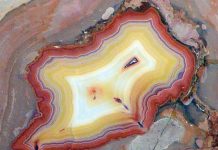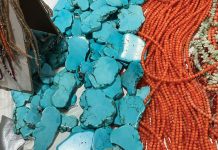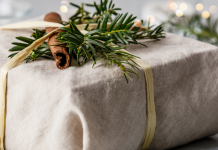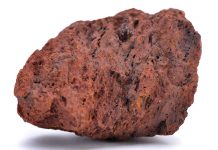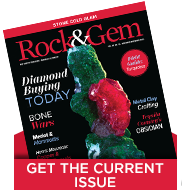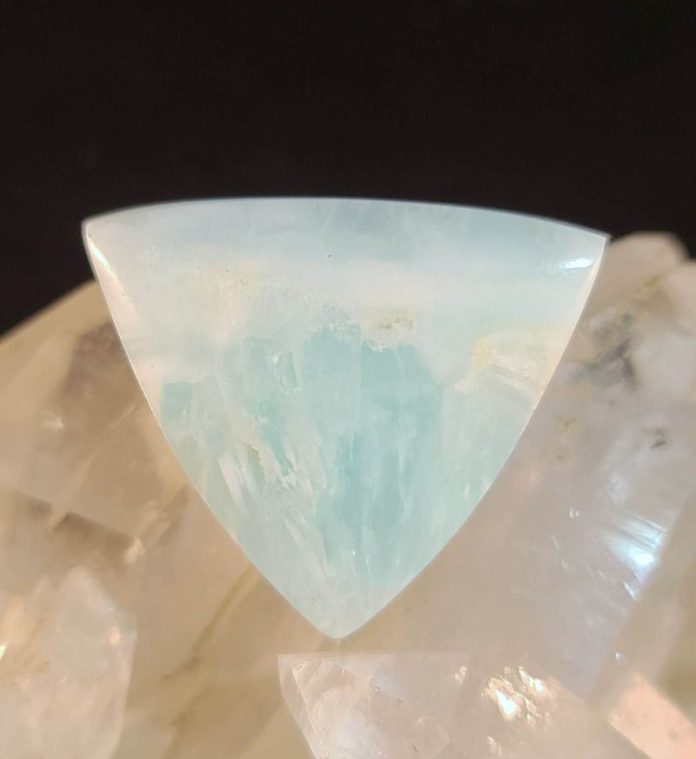
Hemimorphite can be found all around the world, predominantly surrounding zinc mines. For many years, hemimorphite and smithsonite were believed to be one in the same mineral. At that time, it was called calamine, the very same that is used as a household lotion for sunburns.
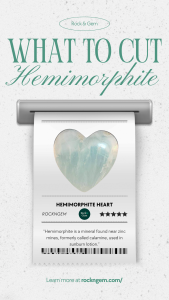
Hemimorphite Colors and Lapidary Uses
Most hemimorphite specimens are collector’s pieces, usually small drusy clusters in a pocket of its host stone. Hemimorphite also can be found in facet gem grade and lapidary grade material that can be cut into cabochons.
Hemimorphite has a wide range of blue to green colors that catch your attention. Many of the gem-grade materials can be deep blue, and the lapidary grade is usually a beautiful glacier ice blue.
This material should be used cautiously for jewelry pieces since it’s only a 4.5 to 5 on the Moh’s scale of Hardness and can be extremely fragile. Working with this mineral will also create some challenges since it’s not only soft but resistant to a high polish.
 Buying Hemimorphite: What to Look For
Buying Hemimorphite: What to Look For
Purchasing hemimorphite can also be a challenge because it’s not always readily available at shows, however, it can be found online if you keep your eyes peeled. There are many seams of rough being sold that come from China. They can be half a pound to a couple of pounds in size and you can usually see how much color is showing from the outer edges.
The white rind isn’t something you can count on to be included in your cabochon designs since it’s so soft that it can be easily sanded away with a 600-grit soft resin wheel. When picking out your pieces, be sure to have the color areas measured to be able to cut cabochons.
How to Cut Slabs and Preforms
When starting to cut your rough, I like to set the saw to its highest speed and cut with the thinnest blade possible. I also like to use a 10-inch trim saw and cut by hand to gain added control of pressure and avoid any breakage as each slab gets cut. This is also important as you close in on the very end of each slab. Slowing down to a crawl at the tail end helps to make sure that it cuts cleanly through and doesn’t chip a large chunk off the end.
Once you have your slabs cut, and you’re ready to draw out your preform shapes, DO NOT use a Sharpie pen on this material because it will bleed into the grain of the stone and penetrate deeper than you might want it to go. Using a pencil is your best bet. Always add a little extra room around the edges as a precautionary measure because this material is so soft that it can grind away quickly.
 Cabbing and Finishing Tips for Hemimorphite
Cabbing and Finishing Tips for Hemimorphite
Once you’re ready to start cabbing, using light touch is always best. Depending on your setup, a course 80-grit steel wheel is not suggested. Start with either a 220-steel wheel or a 140-soft resin wheel to shape and dome your cab. Once it’s shaped, allow your 280-grit soft wheel to smooth it out, but still with a gentle touch. By this point, you should have a nice smooth, domed cab, with little to no scratches.
From this point, continue on your general routine from the 600-to 3k grit wheels. I would not suggest any higher than 8k grit, because you won’t see much difference and the heat from friction on the higher grit wheels might put a haze on your polish. Instead of polishing up to the 14k grit wheel, lightly use a polishing compound, like Zam on a felt tip bit with a Dremel. Work with small areas at a time, trying not to overheat the stone.
This story about hemimorphite previously appeared in Rock & Gem magazine. Click here to subscribe. Story and photos by Russ Kaniuth.


